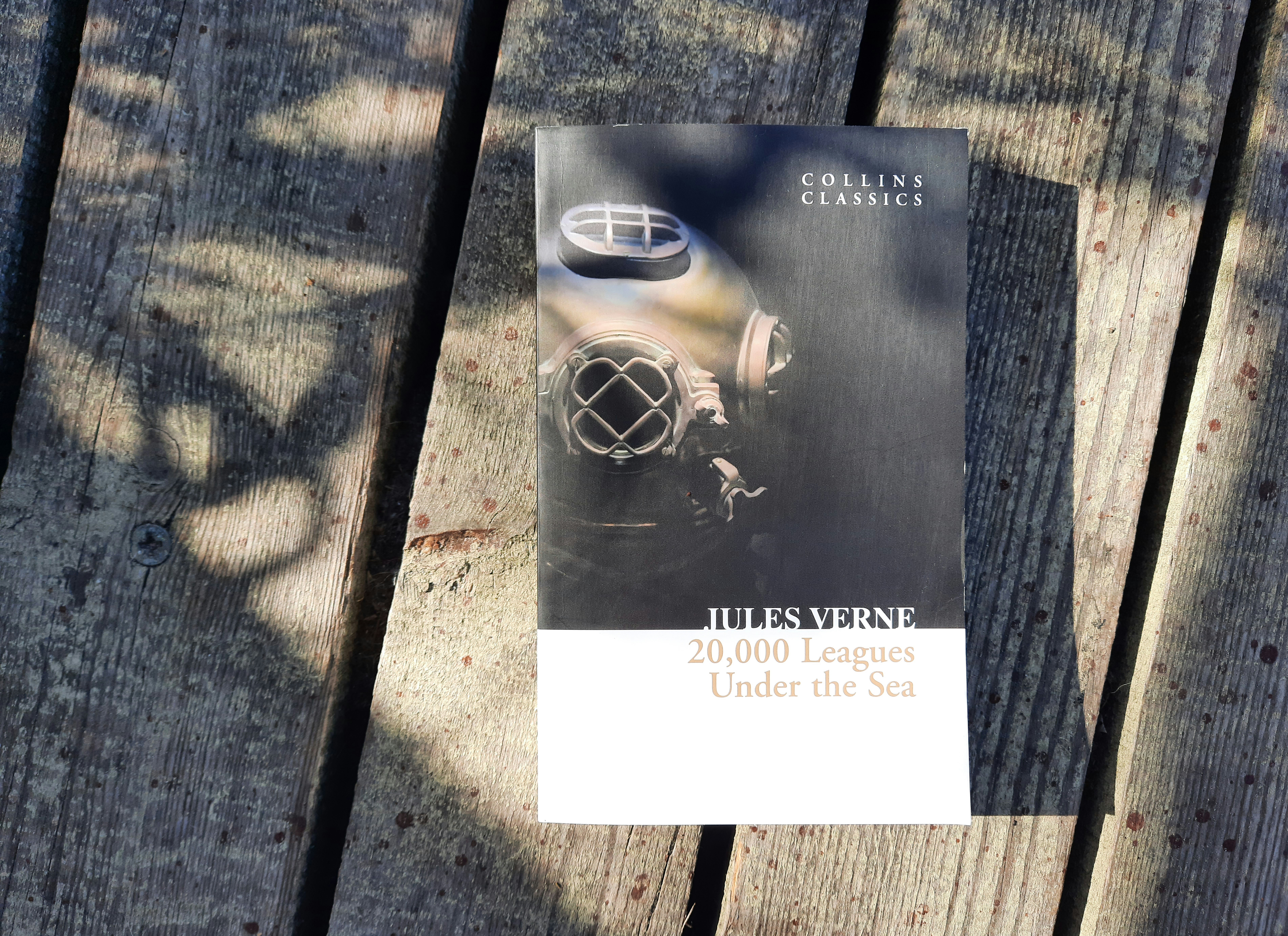“Space exploration and underwater exploration are very similar,” says Sergio Gamberini in When I Grow Up interview. As a manufacturer of diving equipment and creator of Nemo’s Garden – where he grows food and flowers under the sea – he knows underwater challenges quite well.
This week I want to explore the depths of diving and how much it is like floating among the stars. In the Sea Library’s books I will be searching for aquanauts. First book that I take from my shelf is a nineteenth century classic – Jules Verne’s wondrous story 20’000 Leagues Under the Sea.
In a chapter A Walk on the Bottom of the Sea Captain Nemo and his captive guests go for an underwater stroll in hope to hunt some big fish. First, they have to dress accordingly, so they could breathe underwater for a whole day. Inventions at that time married with Verne’s imagination have made a sci-fi scene possible and mind-blowing for nineteenth century and beyond. Jules Verne has to tailor the equipment well enough for a reader to believe.

“At the Captain’s call two of the ship’s crew came to help us dress in these heavy and impervious clothes, made of india-rubber without seam, and constructed expressly to resist considerable pressure. One would have thought it a suit of armour, both supple and resisting. This suit formed trousers and waistcoat. The trousers were finished off with thick boots, weighted with heavy leaden soles. The texture of the waistcoat was held together by bands of copper, which crossed the chest, protecting it from the great pressure of the water, and leaving the lungs free to act; the sleeves ended in gloves, which in no way restrained the movement of the hands. There was a vast difference noticeable between these consummate apparatuses and the old cork breastplates, jackets, and other contrivances in vogue during the eighteenth century.”
“Verne’s agenda was really asking the question ‘what if?’,” writes Gerard Cheshire in the introduction of my copy of the book, published by Collins Classics in 2010. “What if people could dig to the centre of the earth, travel beneath the waves, journey to the moon or fly around the world? As a consequence, he quite logically invented the vehicles and equipment he imagined they would need. He was being pragmatic and he implemented his contemporaneous understanding of science in both designing paraphernalia and deciding what problems different environments might throw up.”
“The upper part of our dress terminated in a copper collar upon which was screwed the metal helmet. Three holes, protected by thick glass, allowed us to see in all directions, by simply turning our head in the interior of the head-dress. As soon as it was in position, the Rouquayrol apparatus on our backs began to act; and, for my part, I could breathe with ease.”
Tomorrow for a weekly When I Grow Up interview Kids Sea Library will talk to a real aquanaut. Meanwhile, if you want to borrow Jules Verne’s books from the Sea Library, let me know. I send them by an (overground, not underwater, sadly) post as well.
***
“Visuma izpētei un zemūdens izpētei ir daudz kopīga,” intervijā man saka Serdžio Gamberīnī. Kā niršanas ekipējuma ražotājs un “Nemo dārza” radītājs, audzējot pārtiku un puķes zem jūras, ar zemūdens izaicinājumiem viņš ir labi pazīstams.
Šonedēļ gribu doties dzīlēs un uzzināt, cik ļoti niršana ir pielīdzināma ceļojumam zvaigznēs. Jūras bibliotēkas grāmatās meklēšu akvanautus. Pirmā grāmata, kuru paņemu no plaukta, ir 19. gadsimta klasika – Žila Verna “20’000 ljē pa jūras dzelmi”.

Nodaļā “Gājiens pa jūras dibenu” Kapteinis Nemo un viņa sagūstītie viesi dodas zemūdens pastaigā ar cerību nomedīt kādu lielu zivi. Vispirms viņiem ir attiecīgi jāsaģērbas, lai elpošana zem ūdens visas dienas garumā būtu iespējama. Tālaika izgudrojumi savienojumā ar Verna iztēli ir uzbūruši zinātniskās fantastikas ainu, kas bija prātam neaptveram 19. gadsimtā un ne tikai tad. Ticamības nodrošināšanai autoram nācās “pašūt” nevainojamu ekipējumu.
“Uz kapteiņa saucienu ieradās divi kuģa kalpotāji palīdzēt mums uzvilkt šos platos ūdens necaurlaidīgos kaučuka apģērbus bez šuvēm, kuri bija pagatavoti tā, ka varētu izturēt ievērojamu spiedienu. Tas bija kaut kas līdzīgs lokanām un atsperīgām bruņām. Tikai bikses un veste, vairāk nekā. Bikšu galos biezi zābaki ar smagām svina zolēm. Vestes audumu uz krūtīm saturēja izliektas vara stīpas, lai atturētu ūdens spiedienu un plaušām ļautu brīvi darboties. Piedurkņu galos bija lokani cimdi, tā ka nekas netraucēja pirkstu kustības. Acīm redzot šie pārlabotie uzvalki nesalīdzināmi pārāki par vecajiem, slavenajiem astoņpadsmitā gadu simtenī izgudrotiem, ar korķa apvalku, bezpiedurkņu vesti, ūdens svārkiem, kastēm un tā joprojām.”
“Vernu galvenokārt nodarbināja jautājums “ja nu?”,” 2010. gada angļu izdevuma ievadā raksta Žerārs Česīrs (Gerard Cheshire). “Ja nu cilvēki varētu aizrakties līdz Zemes centram, ceļot zem viļņiem, doties uz Mēnesi vai aplidot apkārt pasaulei? Rezultātā viņš diezgan loģiski izgudroja pārvietošanās līdzekļus un nepieciešamo ekipējumu. Viņš bija pragmatisks un pielietoja sava laika zinātnes atklājumus un sasniegumus, lai uz papīra radītu atribūtiku un paredzētu, kādus izaicinājumus šīs dažādās vides varētu ceļotājiem mest.”
“Uzvalka augšgals nobeidzās ar vītņotu vara apkakli, kurai tika pieskrūvēta metāla kaska. Pa trijiem ar biezu stiklu aizsegtiem caurumiem, galvu tikai pagriežot šīs bumbas iekšienē, bija iespējams pārredzēt visu apkārtni. Uz mūsu mugurām piestiprinātie Rukveirola aparāti sāka darboties, un es tūliņ pamanīju, ka varu elpot pilnīgi brīvi.”
Rītdien iknedēļas “Kad izaugšu” interviju sērijā publicēšu Bērnu Jūras bibliotēkas sarunu ar mūsdienu akvanautu. Bet tikmēr – ja vēlies aizņemties Žila Verna grāmatas, dod ziņu! Sūtu tās arī pa (pagaidām gan tikai virszemes) pastu.

Lots of unknown territory and monsters still to be discovered.
LikeLiked by 1 person
yes, lots and lots !
LikeLiked by 1 person
Amazing!!
I read the book when i was about 15 years old and traveled thorouth it into the depth of ocean.
LikeLiked by 1 person